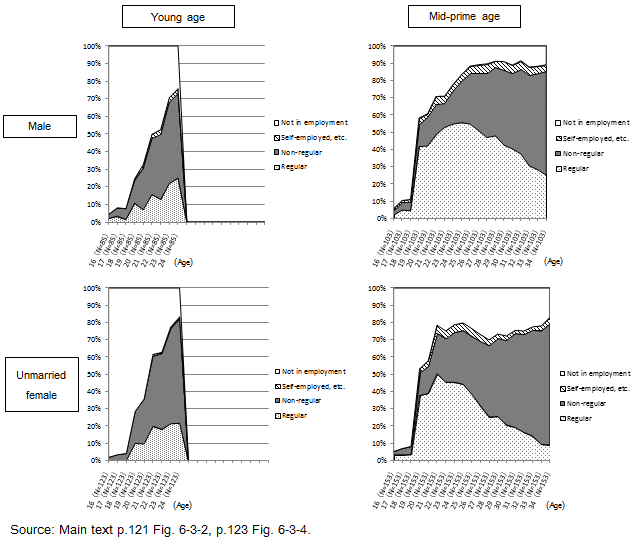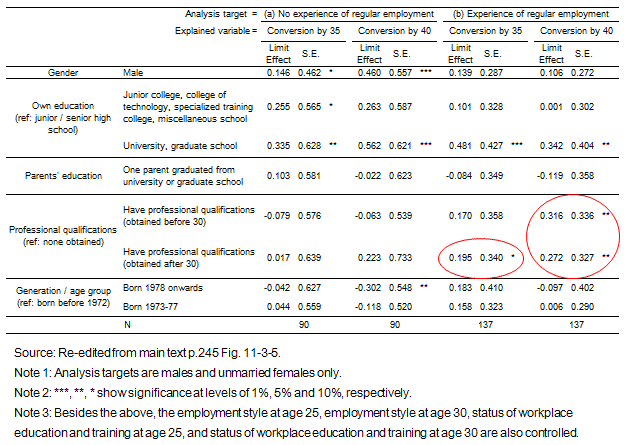JILPT Research Report No.180
Research on the Work and Lives of Non-Regular Workers in Mid-Prime Age:
With focus on career analysis
September 18, 2015
Summary
Research Objective
More than two decades have passed since the increase in young non-regular workers started to be seen as a problem, and the first people to graduate during the period known as the “employment ice age” are now entering their 40s. As a result, the number of non-regular workers in the 35-44 age bracket is growing. It reached 1.49 million as of 2014, excluding married females.
In this Research, non-regular workers aged between 35 and 44 (the “mid-prime-age” bracket) are called “non-regular workers in mid-prime age”, to distinguish them from those in the 25-34 age bracket (young non-regular workers). The purpose of the Research is to clarify (1) what has caused them to take up non-regular employment, (2) the current situation of their work and lives, and (3) the conditions needed to enhance their careers from now on.
Research Method
For this Research, we made an interview survey with 25 men and women (including non-regular workers in mid-prime age) in FY2012, and collected hypothetical information on points (1), (2) and (3) above (see Research Material Series No.126).
Based on the findings obtained from the above, a nationwide questionnaire survey under the title “Questionnaire Survey on Vocational Careers and Working Styles” was conducted in July and August 2013, using a combination of Life History Calendars (LHC) and normal questionnaires. The survey targets were 10,000 persons aged 25-44 throughout Japan (3,000 aged 25-34 plus 7,000 aged 35-44), from whom 4,970 valid responses were received (valid response rate 49.7%). In Research Report No.164 published in May 2014, this nationwide questionnaire survey was used to analyze point (2) above, i.e. the current situation of work and lives of non-regular workers in mid-prime age.
As well as analyzing point (2) in more detail, this Research Report will use LHC data to analyze (1) what causes people to take up non-regular employment, and (3) conditions needed to enhance careers from now on.
Major Findings
- Non-regular workers in mid-prime age tend to have significantly lower levels of job difficulty and annual income than regular workers in the same age group. Focusing on men and unmarried women in particular, it was confirmed that they have lower equivalent incomes and greater dissatisfaction with life, often take up non-regular employment involuntarily, and have low job satisfaction. In addition, male and unmarried female “involuntary” non-regular workers in the mid-prime-age bracket faced more serious issues in both work and life than young “involuntary” non-regular workers.
- Many male and unmarried female non-regular workers in mid-prime age had worked in regular employment in their younger years (Figure 1). Based on this, we investigated the mechanism whereby workers quit regular employment to take up non-regular employment, and it was suggested that workers who have experienced overwork or harassment in a past workplace are more likely to switch to non-regular employment. Another suggestion was that experience of “illness or injury” related to work increases the likelihood of becoming a non-regular worker in mid-prime age.
Figure 1. Past careers of non-regular workers

- The ratio of male and unmarried female non-regular workers in mid-prime age wishing to convert to regular employment is almost the same as that of young non-regular workers. Moreover, the analysis showed that people who have had experience of regular employment in the past, even if in non-regular employment or not in employment at age 30, are more likely to be able to convert to regular employment subsequently by acquiring vocational qualifications or through self-development (Figure 2). Also, though not necessarily limited to the mid-prime-age bracket, it was shown that using “Hello Work” (Public Employment Security Offices) as a route for career change increases the likelihood of converting from non-regular to regular employment.
Figure 2. Factors causing a conversion from non-regular employment or non-employment to regular employment after 30 years old (Probit analysis)

- However, whether through a career change or through internal promotion, it was shown that shifting from non-regular to regular employment was more likely to occur in younger age brackets up to the 20s. Another finding was that conversion to regular employment after age 30 tends to be limited to certain occupations or industries, and that even if older non-regular workers successfully convert to regular employment, the accompanying increase in income is smaller. On the other hand, it was also shown that the labor market for non-regular employment includes a route to increasing income (albeit narrow and uncertain) by continuing in the same occupation, and that even with the same years of experience in the same occupation, workers who take part in training at their company’s expense during this time see bigger increases in income.
Policy Implications
- In the case of men and unmarried women, in particular, non-regular workers in mid-prime age, though numerically fewer than young non-regular workers, face greater difficulties in both work and life. If these people end their vocational careers while still on low incomes, or have not been contributing to pensions for long enough at that point, they will be sowing the seeds of major problems in future, not only for their own lives in old age, but also in terms of the social security system. Seen in this light, there is an extremely great need for non-regular workers in mid-prime age to be highlighted as targets of labor policy. Furthermore, the work and life situations of non-regular workers in mid-prime age vary greatly, depending on their occupations, their reasons choosing non-regular employment, etc. When devising measures to support them, therefore, care should be taken to define the target population appropriately and deliver more support to those who need it most.
- Improving the workplace environments and working styles of regular employees could halt the increase in non-regular workers in mid-prime age. Conversely, non-regular workers in mid-prime age could also increase if harassment and other workplace problems were allowed to continue unchecked. Besides these, a balance between medical treatment and vocational life and the introduction of systems of short-hour regular employee status― not limited to temporary short-hour working systems― should be promoted, to ensure that workers succumbing to illness or injury are not disadvantaged.
- As with young non-regular workers, policies revolving around support for conversion to regular employment should also be devised for non-regular workers in mid-prime age. For example, a higher subsidy rate for older non-regular workers could be set in the “Conversion to Regular Employment” course of the Subsidy for Upgrading Careers. Besides this, other measures could include making non-regular workers who obtain qualifications eligible for subsidies under the “Human Resources Development” course of the same subsidy (and setting a higher subsidy ratio for older non-regular workers). Meanwhile, it would also be effective to encourage the use of “Hello Work” by non-regular workers who try to find better career without the help of others.
- As with young non-regular workers, policies revolving around support for conversion to regular employment should also be devised for non-regular workers in mid-prime age. For example, a higher subsidy rate for older non-regular workers could be set in the “Conversion to Regular Employment” course of the Subsidy for Upgrading Careers. Besides this, other measures could include making non-regular workers who obtain qualifications eligible for subsidies under the “Human Resources Development” course of the same subsidy (and setting a higher subsidy ratio for older non-regular workers). Meanwhile, it would also be effective to encourage the use of “Hello Work” by non-regular workers who try to find better career without the help of others.
Policy Contribution
As well as stressing the importance of positioning non-regular workers in mid-prime age as targets of labor policy, directions for the necessary policies have been proposed from an evidence-based policy Research standpoint.
Contents (available only in Japanese)
- JILPT Research Report No.180, full text (PDF:14.2MB)
If it takes too long to download the whole text, please access each file separately.
- Chapter 1 Introduction (PDF:688KB)
- Part I Analysis of Current Situation (Chapters 2-5) (PDF:2.7MB)
- Part II Analysis of Causes (Chapters 6-8) (PDF:5.8MB)
- Part III Steps for Career Enhancement (Chapters 9-13) (PDF:3.4MB)
- Chapter 14 Conclusion (PDF:373KB)
- Appendix: “Questionnaire Survey on Vocational Careers and Working Styles” survey form (PDF:1.3MB)
Research Category
Project Research: “Research on Strategic Labor/Employment Policies for Non-regular Workers”
Subtheme: “Survey Research on diverse ways of working in both regular and non-regular employment”
Research Period
FY2012-2016 (this Research Report written FY2014-2015)
Author
- Koji TAKAHASHI
- Vice Senior Researcher, The Japan Institute for Labour Policy and Training
- Shingou IKEDA
- Vice Senior Researcher, The Japan Institute for Labour Policy and Training
- Haruhiko HORI
- Vice Senior Researcher, The Japan Institute for Labour Policy and Training
- Yasutaka FUKUI
- Project Assistant Professor, Institute of Gerontology, University of Tokyo
- Qingya LEE
- Assistant Fellow, The Japan Institute for Labour Policy and Training
- Tomohiko MORIYAMA
- Research Assistant Professor, Faculty of Economics, Shimonoseki City University
- Toru KOBAYASHI
- Researcher, The Japan Institute for Labour Policy and Training
Related Research Report
- Research Material Series No.126 “Mid-Prime-Age Non-Regular Employment – From Individual Interview Surveys” (September 2013)
- JILPT Research Report No.164 “Research on the Work and Lives of Middle-Aged (35-44) Non-Regular Workers: Analysis of present situation” (Summary) (May 2014)
- Research Series No.143 “Japanese Vocational Careers and Working Styles: From the Results of the JILPT Questionnaire Survey on Vocational Careers and Working Styles” (June 2015)
- Koji, TAKAHASHI “The Work and Lives of Japanese Non-Regular Workers in the “Mid-Prime-Age” Bracket (Age 35-44) (PDF:2.36KB)” Japan Labor Review Vol.12 No.3 (Summer 2015)
Category
Employment / Unemployment, Diversified working styles
JILPT Research Report at a Glance
| To view PDF files, you will need Adobe Acrobat Reader Software installed on your computer.The Adobe Acrobat Reader can be downloaded from this banner. |

